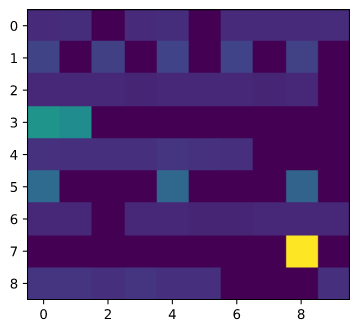Control Theory Augment
CT Augment是论文ReMixmatch中提出的一种不需要通过控制方法不需要使用强化学习即可调整数据增强测量的一种方法。今天仔细学习一下。
- 初始化选择概率矩阵
首先,CTAugment将每个变化的每个参数范围划分为数个分组,在开始训练时将每个分组的权重设置为1,比如一共9种数据增强ops,数据增强分级为10级,此时权重参数log_prob形状为[9,10]。同时设置更新速率矩阵rates为1,形状为[9,10]。
均匀随机选取数据增强方式以及数据增强分级参数
def _sample_ops_uniformly(self) -> [tf.Tensor, tf.Tensor]:
"""Uniformly samples sequence of augmentation ops."""
op_indices = tf.random.uniform(
shape=[self.num_layers], maxval=len(AUG_OPS), dtype=tf.int32)
op_args = tf.random.uniform(shape=[self.num_layers], dtype=tf.float32)
return op_indices, op_args均匀随机选取可以更好覆盖全部情况
根据所选取的参数实施增强得到
probe_data通过模型对
probe_data进行分类,得到probe_probs使用
label得到对应样本的正确分类probe_probs称为proximity根据公式更新
rate矩阵此处的
op_idx, level_idx是之前均匀随机选取的增强操作、分级参数。decay为衰减率默认0.999。alpha = 1 - decay
rate[op_idx, level_idx] += (proximity - rate[op_idx, level_idx]) * alpha当所得到的分类概率较高则
rate会随之增加,反之则降低。将
rate转换为选择概率probsprobs = tf.maximum(self.rates, self.epsilon)
probs = probs / tf.reduce_max(probs, axis=1, keepdims=True) # 将概率锐化,类似softmax
probs = tf.where(probs < self.confidence_threshold, tf.zeros_like(probs),
probs) # 如果概率小于阈值,那么设置为0
probs = probs + self.epsilon # 防止概率为0
probs = probs / tf.reduce_sum(probs, axis=1, keepdims=True) # 再次锐化将
probs更新到log_prob对于训练的样本则根据
log_prob进行数据增强参数的选取。def _sample_ops(self, local_log_prob):
"""Samples sequence of augmentation ops using current probabilities."""
# choose operations
op_indices = tf.random.uniform(
shape=[self.num_layers], maxval=len(AUG_OPS), dtype=tf.int32)
# sample arguments for each selected operation
selected_ops_log_probs = tf.gather(local_log_prob, op_indices, axis=0)
op_args = tf.random.categorical(selected_ops_log_probs, num_samples=1)
op_args = tf.cast(tf.squeeze(op_args, axis=1), tf.float32)
op_args = (op_args + tf.random.uniform([self.num_layers])) / self.num_levels
return op_indices, op_args重复以上过程。
总结
整个更新过程就是这样。通过选取对应的数据增强种类,得到此数据增强下的分类概率,当分类概率低时,rate会降低,经过锐化后此数据增强被选中的概率也会降低。其中decay控制了更新速率。还有confidence_threshold,我觉得可能要batch越大的时候才比较有用,如果batch较小很难一次性更新rate超过confidence_threshold,如果没有超过confidence_threshold那么此数据增强被选中的概率依旧还是比较低的。
所实话对于虽然不用强化学习的方法来更新数据增强策略了,但这两个超参数的选取还是有点头疼。并且这个控制方式缺少一定的收敛性分析。我训练半天的选取概率矩阵如下:
[0.11852807, 0.13082333, 0.00013127, 0.12403152, 0.13140538, 0.00013127, 0.1205155 , 0.12174512, 0.12513067, 0.12755796],
[0.20564014, 0.00020543, 0.19176407, 0.00020543, 0.2006021 , 0.00020543, 0.20226233, 0.00020543, 0.19870412, 0.00020543],
[0.11055039, 0.11402953, 0.11110956, 0.1050452 , 0.11322882, 0.11464192, 0.11097319, 0.10542616, 0.11488046, 0.00011477],
[0.51186407, 0.48404494, 0.00051135, 0.00051135, 0.00051135, 0.00051135, 0.00051135, 0.00051135, 0.00051135, 0.00051135],
[0.14486092, 0.1384983 , 0.14066745, 0.13853313, 0.15168588, 0.1444478 , 0.14085191, 0.00015153, 0.00015153, 0.00015153],
[0.34809318, 0.00034775, 0.00034775, 0.00034775, 0.3339483 , 0.00034775, 0.00034775, 0.00034775, 0.31552422, 0.00034775],
[0.11353768, 0.11433525, 0.00011519, 0.11392737, 0.11094389, 0.10420952, 0.10411835, 0.11530466, 0.11302778, 0.11048029],
[0.0009901 , 0.0009901 , 0.0009901 , 0.0009901 , 0.0009901 , 0.0009901 , 0.0009901 , 0.0009901 , 0.99108905, 0.0009901 ],
[0.14962535, 0.15079339, 0.13698637, 0.14928676, 0.13616142, 0.13792172, 0.00015064, 0.00015064, 0.00015064, 0.13877314]
可视化效果如下,这个0.99108905我感觉很有可能是恰好上个probe使用了这个增强,但是一下就把概率拉到0.99也太夸张了把,按道理应该是越弱的增强级别概率越大才对。
